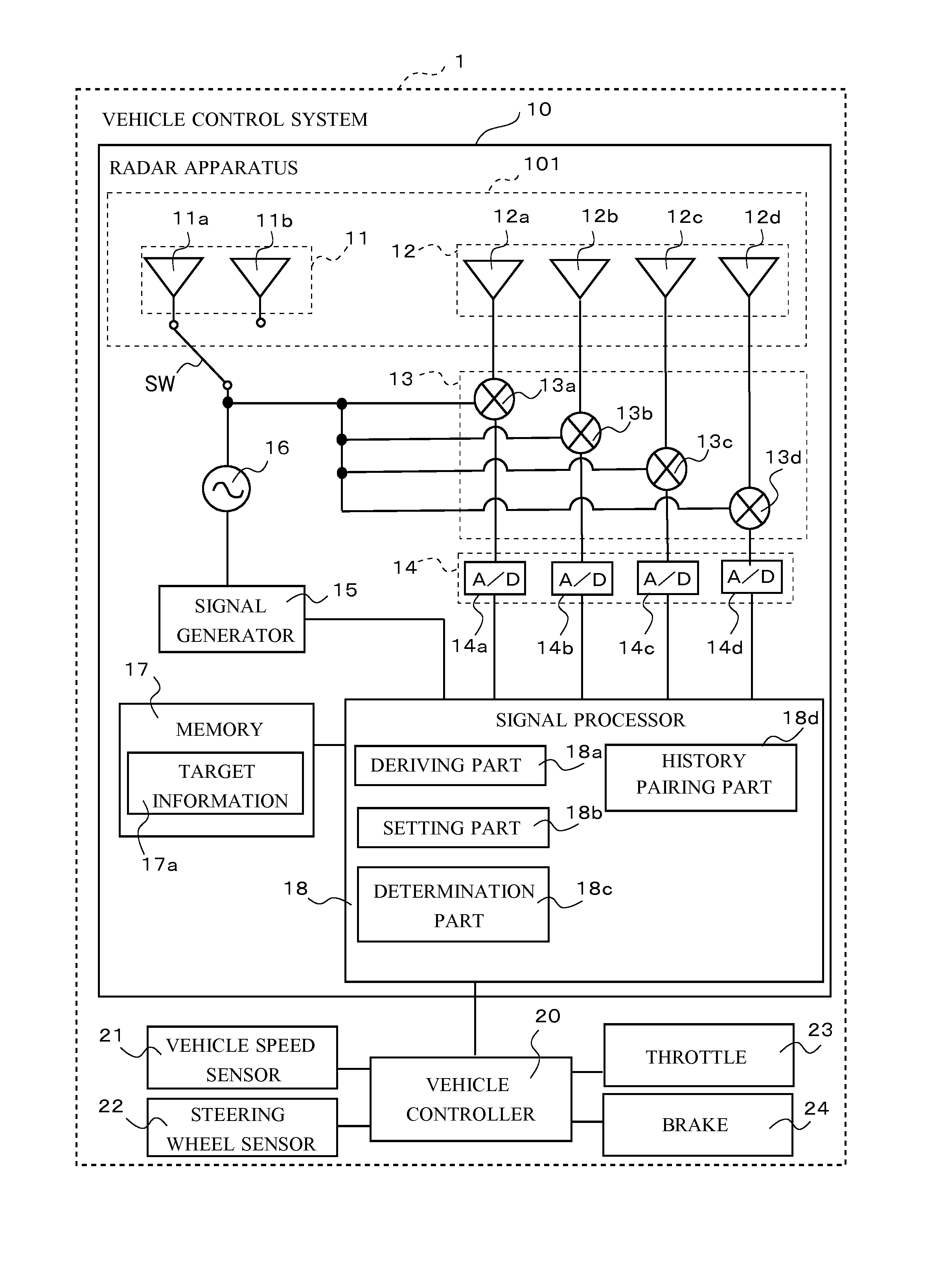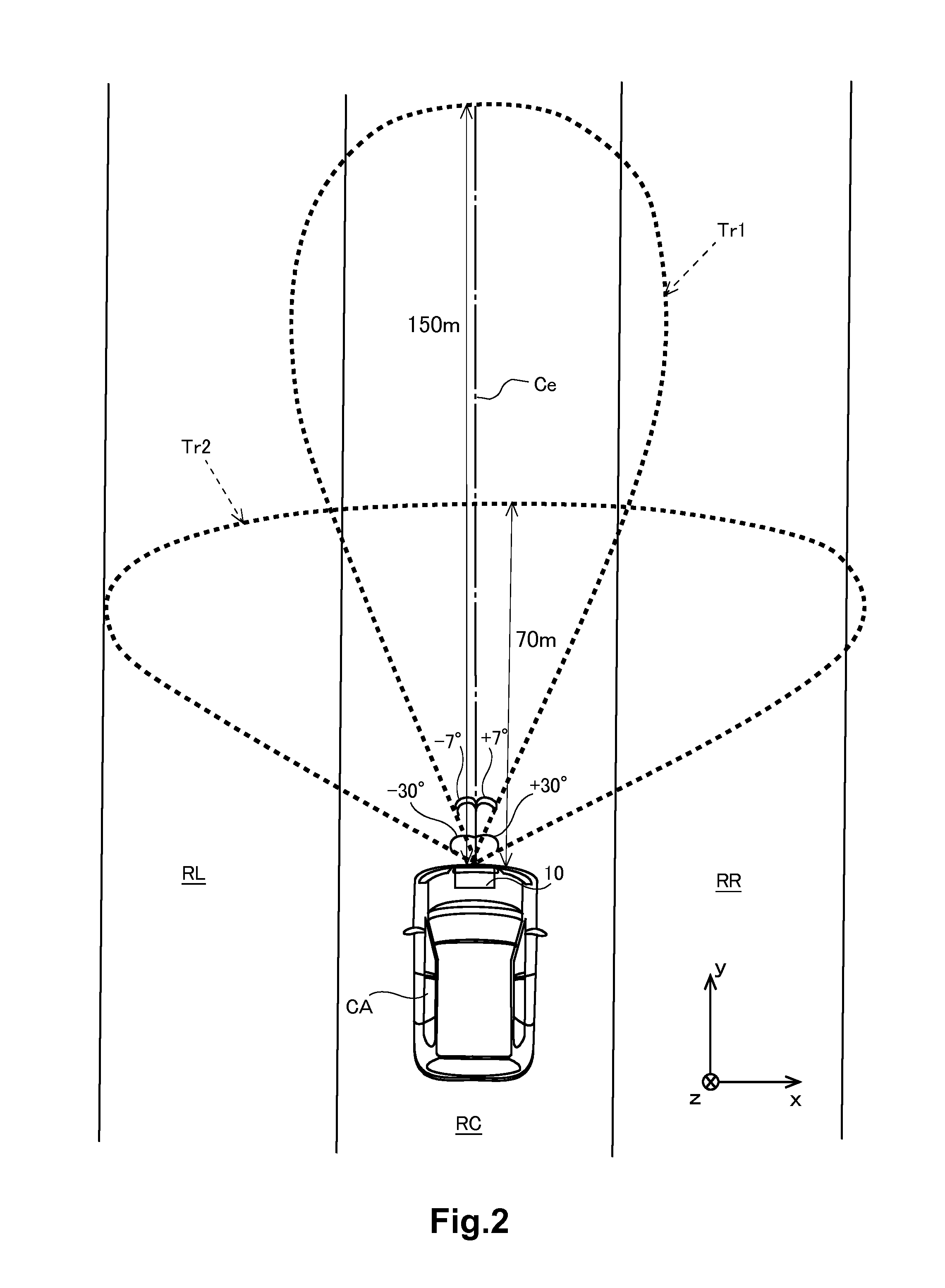Radar apparatus
a technology of radar and apparatus, applied in the field of signal processing, can solve the problems that the controller that controls the vehicle may not perform proper control, and achieve the effects of reducing processing load, minimizing extrapolation process, and reducing processing load
- Summary
- Abstract
- Description
- Claims
- Application Information
AI Technical Summary
Benefits of technology
Problems solved by technology
Method used
Image
Examples
second embodiment
[0146]Next, a second embodiment is described. A signal processor 18 of a radar apparatus 10 in the second embodiment performs a process of finalizing a combination of angle peak signals as a history pair data set by reducing an angle range of a prediction region as a longitudinal distance of a target becomes greater, in the history pairing process explained in the first embodiment.
[0147]Generally, as the longitudinal distance becomes greater, a distance corresponding to a prediction angle range that is the angle range of the prediction region becomes greater. As the longitudinal distance becomes greater, even if the angle range is fixed (e.g. ±4 degrees), a lateral distance becomes greater. Thus, in a case where a target exists in a current traffic lane in a relatively long distance, a process of re-pairing of a different combination performed by a history pairing part 18d in the first embodiment may include an angle peak signal of a target existing outside a range of the current tr...
third embodiment
[0157]Next, a third embodiment is explained. In a case where an angle peak signal exists in a relatively short distance from a vehicle CA in a current traffic lane RC in which the vehicle CA is traveling, a signal processor 18 of a radar apparatus 10 in the third embodiment performs a process of re-pairing (the steps S135 to S137 in FIG. 10). In other words, in a case where the angle peak signal exists in a relatively long distance from the vehicle CA or in a case where the angle peak signal exists in at least one of a left next traffic lane RL and a right next traffic lane RR but does not exist in the current traffic lane RC in which the vehicle CA is traveling, the signal processor 18 does not perform the process of re-pairing but performs only the process of history pairing based on the Mahalanobis distance. Due to those processes, the signal processor 18 can reduce processing load caused by derivation of target information and can prevent from finalizing a wrong combination of t...
fourth embodiment
[0168]Next a fourth embodiment is explained. A signal processor 18 of a radar apparatus 10 in the fourth embodiment selects only an angle peak signal existing in a range of a current traffic lane defined based on a relative lateral distance, as an object signal for re-pairing in the history pairing process described in the first embodiment.
[0169]Concretely, the signal processor 18 obtains a radius value of a curve relating to a current traffic lane RC in which a vehicle CA is traveling, from a vehicle controller 20. The radius value of the curve is derived by the vehicle controller 20 based on a rotation angle of a steering wheel sensor 22. The radius value of the curve may be derived in a different method, for example, based on an image captured by a camera. The signal processor 18 calculates a relative lateral distance of the angle peak signal based on the radius of the curve and selects the angle peak signal of which the relative lateral distance is in the current traffic lane RC...
PUM
 Login to View More
Login to View More Abstract
Description
Claims
Application Information
 Login to View More
Login to View More - R&D
- Intellectual Property
- Life Sciences
- Materials
- Tech Scout
- Unparalleled Data Quality
- Higher Quality Content
- 60% Fewer Hallucinations
Browse by: Latest US Patents, China's latest patents, Technical Efficacy Thesaurus, Application Domain, Technology Topic, Popular Technical Reports.
© 2025 PatSnap. All rights reserved.Legal|Privacy policy|Modern Slavery Act Transparency Statement|Sitemap|About US| Contact US: help@patsnap.com



